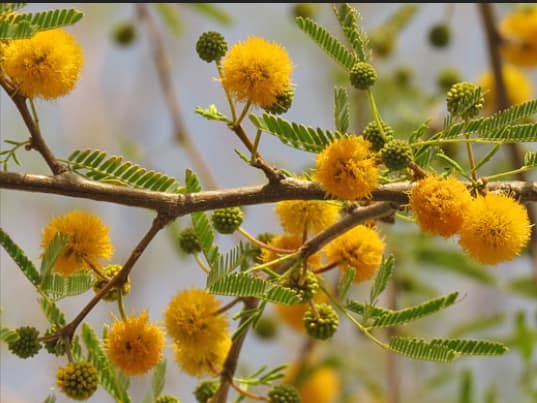Uses, Benefits & Botanical Facts

Acacia farnesiana, also known by its updated botanical name Vachellia farnesiana, is a thorny shrub or small tree widely recognized for its fragrant yellow flowers and traditional medicinal value. Commonly referred to as Sweet Acacia, Needle Bush, or Huisache, it holds various regional names in India, including Babul, Kikar, and Vilayati Babool. However, it is important to note that the term “Babool” is also used for Acacia nilotica, a different species, so accurate botanical identification is essential.
🌿 Common Names of Acacia farnesiana
Scientific name: Acacia farnesiana (now Vachellia farnesiana)
- Other names: Sweet Acacia, Needle Bush, Huisache
- In India/Hindi: It is often called Babul, Kikar, or Vilayati Babool in Hindi and other regional languages. However, note that “Babul” can also refer to Acacia nilotica, so identification is important.
🌍 Origin and Distribution of Acacia farnesiana
- Native to: Tropical America
- Now naturalized and widely grown in: India, Africa, Australia, Southeast Asia, and other warm regions.
- In India, it grows in dry, arid regions and along roadsides or open lands.
you may also like https://thrievly.com/ayurvedic-treatment-for-back-pain-and-sciatica/
🌸 Description
- A thorny shrub or small tree, 4.5–9 meters tall.
- Produces yellow, fragrant flowers.
- Evergreen or deciduous, depending on the climate.
- Each leaf base has a pair of thorns.
Botanically, Acacia farnesiana belongs to the Fabaceae (legume) family and grows as a multi-branched shrub or tree reaching heights of 4.5 to 9 meters. The plant bears small, golden-yellow, globe-shaped flowers known for their strong, sweet fragrance. These blooms typically appear in clusters and are a primary source of farnesol, a naturally occurring alcohol used in perfumes and cosmetics. The leaves are bipinnate, and each leaf base features a pair of sharp thorns, which makes the plant effective for use in natural fencing or live hedges. The tree may remain evergreen or deciduous, depending on local climate conditions.
you may also like https://thrievly.com/understanding-pcod-pcos-and-its-ayurvedic-treatment/
🌼 Health Benefits and Uses
- Fragrance: Flowers are used in perfumes due to their sweet aroma. The compound farnesol (used in fragrances and cosmetics) is named after this plant.
- Wound healing: Traditional use of leaves and bark for healing cuts, wounds, and skin infections.
- Anti-inflammatory: May help reduce inflammation and swelling when used as a poultice.
- Digestive aid: Parts of the plant are sometimes used in traditional remedies to treat stomach disorders.
- Antiseptic: The bark has mild antiseptic properties.
- Ornamental: Planted for its attractive flowers and natural fencing due to its thorns.
In traditional medicine systems, especially folk and rural practices, Acacia farnesiana is used for a variety of therapeutic purposes. The leaves and bark are applied topically to treat cuts, wounds, and minor skin infections, thanks to their mild antiseptic and astringent properties. The bark is also known to have anti-inflammatory effects and can be used as a poultice to reduce swelling. In some traditional remedies, the plant is consumed in small, controlled amounts to aid digestion and treat stomach-related ailments.
Aside from its medicinal roles, Acacia farnesiana is valued for its ornamental beauty. The sweet-smelling yellow flowers make it a desirable plant for gardens and landscape decoration, especially in regions with dry climates. The durable wood is sometimes used for making tools, handles, and small furniture, although this is more common in rural settings.
While generally considered safe when used externally or in small doses, excessive or improper internal use can be harmful. Therefore, any medicinal use—especially ingestion—should be carried out under the supervision of a qualified herbalist or Ayurvedic practitioner.



